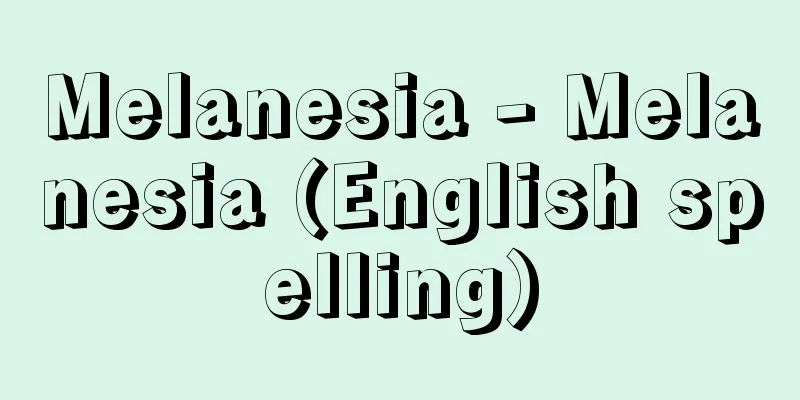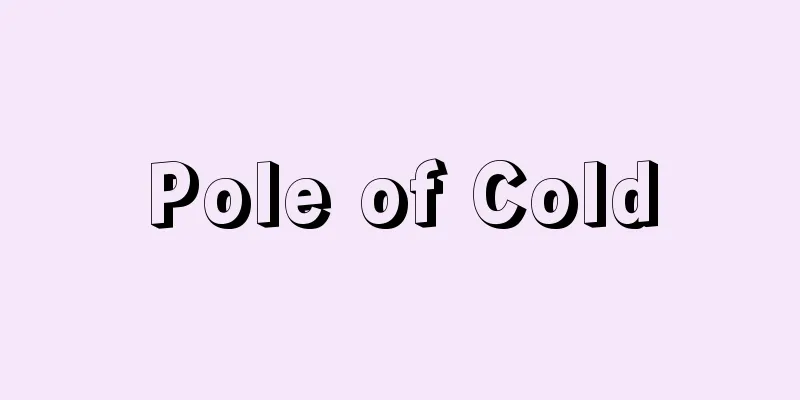Melanesia - Melanesia (English spelling)

|
The islands of the southwest Pacific Ocean, separated from Polynesia to the east by the 180th meridian and connected to Micronesia to the north by the equator. The islands include the northeast of Australia, Papua New Guinea, the Bismarck Islands, the Solomon Islands, the New Hebrides (Vanuatu), New Caledonia, and the Fiji Islands. They have a land area of 525,475 square kilometers and are said to have more than 200 language groups. The word Melanesia means "black islands" and is said to come from the dark brown skin of the inhabitants, but it was first used by the French navigator d'Alville in 1832. Today, it is used as a regional name that divides the Pacific islands into three parts, along with the words Polynesia and Micronesia. Since Papua New Guinea is a large landmass that can be called a semi-continent, it is often considered as a single region called Papua New Guinea, excluding it and its affiliated islands, the Bismarck Islands and the Torres Strait Islands, from Melanesia. Located on the western edge of the Pacific Ring of Fire, the country has many volcanic islands and high mountainous areas covered in tropical rainforests, making development difficult in many areas, but it is also blessed with a variety of mineral resources. During the colonial period, European colonial powers established plantations in the foothills and plains, cultivating coconuts, bananas, coffee, and cacao, and these commercial crops, including copra, are the country's main products, but indigenous societies use root vegetables such as taro and yams, as well as sago palms, as food. After periods of occupation by Britain, France, and other countries, and the fierce battlefield of World War II, the country entered a period of independence in the 1970s, with Fiji gaining independence in 1970, Papua New Guinea in 1975, the Solomon Islands in 1978, and Vanuatu in 1980. [Jouji Oshima] People and CultureRacially, pygmies are broadly divided into three groups: (1) pygmies, (2) Papuans, and (3) Melanesians in the strict sense. Usually, pygmies refer to hunter-gatherers with an average height of less than 150 cm, such as the Negritos of Southeast Asia. However, pygmies in the central highlands of New Guinea have many different characteristics, and the Tapiro, Lamu, and Pesechem pygmies are slash-and-burn farmers. They are also shorter than the surrounding Papuans, but the difference is continuous. Besides the central highlands of New Guinea, short groups live on New Britain, Bougainville, and Malekula. There are two theories about the origin of these pygmies: one is that they were the first immigrants in Oceania, but were later driven into the interior by the advance of Papuans and Melanesians, and the other is that they became short as a result of adapting to the low nutritional conditions of the tropics. The differences in characteristics between Papuans and Melanesians in the strict sense are not so clear. Papuans live in most parts of New Guinea, except for areas inhabited by pygmies. They have dark brown to black skin, long heads, whorled hair, hooked noses, and prominent chins. Melanesians live mainly on the northern coast of New Guinea and on islands in the Melanesia region, especially on the coasts, and have medium heads, wavy hair, broad noses, and rarely prominent chins. Most Papuans speak non-Austronesian languages (Papua), while Melanesians speak Austronesian languages. However, there are cases where Papuans speak Austronesian languages and Melanesians speak Papuan. As such, the races, ethnicities, and languages of Melanesia are extremely complicated. However, it is safe to say that at least the Papuan language family belongs to an earlier cultural period than the Austronesian language family. Migration to Melanesia dates back to 20,000 BC, as can be seen from ruins in the Solomon Islands. In order to understand the origins of Melanesians in the strict sense, it is important to consider the chronology of the pottery culture known as the Lapita style, which existed from Melanesia to western Polynesia from around 1700 BC to several hundred years AD. In Melanesia, slash-and-burn agriculture using digging sticks has been practiced. Root crops such as taro, yams, and bananas are cultivated. The collection of sago starch is important in the lowlands, while sweet potato cultivation is important in the New Guinea highlands. Domestic animals include pigs, chickens, and dogs. Pigs are raised for food as well as for use as ceremonial offerings and as property. Fishing is important along the coasts and islands, while hunting with bows and arrows is important in inland and mountainous areas. Betel nut chewing is a widespread recreational activity. In Melanesia, village societies of several hundred people prevail, and social stratification is underdeveloped. Village chiefs, known as big men, are chosen not by hereditary succession but by social prestige. In Melanesia, belief in supernatural powers known as mana is prominent, and the ancient customs of headhunting and cannibalism were also aimed at obtaining the mana of others. Age hierarchies and coming-of-age ceremonies are common, and various rituals are held in secret societies and men's meeting halls. On the island of New Guinea, mask and statue art has developed significantly. Ancestral spirit worship is also widespread, and there is the custom of preserving skulls. Trading activities using barter, ceremonial gifts, and currency made from shells, dolphin teeth, and feathers are thriving, and the Kula trade in the Massim region of New Guinea is particularly famous. Contact with Western civilization gave rise to numerous millennium movements that sought to acquire wealth and end white rule. Well-known examples are the Maasina Rule movement in the Solomon Islands and the John Hulme movement in Vanuatu. Much of Melanesia achieved independence in the 1970s and 1980s, and began the path to modernization as emerging nations. [Tomoya Akimichi] "We are the Timbu: The vitality of the New Guinea highlanders" by Sachiko Hatanaka (1974, Mikasa Shobo)" ▽ "The South Pacific: An Ethnographic Study" by Eikichi Ishikawa (1979, Kadokawa Shoten)" ▽ "The Pacific: A History of Man in Southeast Asia and Oceania" by Peter Bellwood, translated by Takeshi Ueki and Kenji Hattori (1981, Hosei University Press)" ▽ "The Erota Old Man of Malaita: Field Notes from the Solomon Islands" by Roger M. Keesing, supervised translation by Machiko Aoyagi (1985, Holt Saunders Japan)" ▽ "Oceania (1) Living on Islands" edited by Ryutaro Otsuka, Kazumichi Katayama, and Michiko Indo, "Oceania (2) Living in Tradition" edited by Kenichi Sudo, Tomoya Akimichi, and Satoshi Sakiyama, "Oceania (3)" edited by Akitoshi Shimizu and Masanori Yoshioka Living in Modern Times (1993, University of Tokyo Press)" ▽ "Akimichi Tomoya, Sekine Hisao, and Tai Ryuichi (eds.) "Life History of the Solomon Islands: Culture, History, and Society" (1996, Akashi Shoten)" [Reference] |Source: Shogakukan Encyclopedia Nipponica About Encyclopedia Nipponica Information | Legend |
|
太平洋南西部、ほぼ180度経線によって東のポリネシアと分かたれ、赤道によって北のミクロネシアとくぎられる島々。オーストラリアの北東部、パプア・ニューギニア、ビスマーク諸島からソロモン諸島、ニュー・ヘブリデス諸島(バヌアツ)、ニュー・カレドニア島、フィジー諸島など、52万5475平方キロメートルの陸地面積を有し、そこに200余の言語グループがあるといわれる。メラネシアという語は「黒い島々」という意味で、住民の黒褐色の皮膚に由来するとされるが、1832年フランスの航海者ダルビルがこの語を最初に使った。現在ではポリネシア、ミクロネシアという語とともに太平洋の島々を三分する地域名称として用いられている。なお、パプア・ニューギニアが準大陸ともいうべき大きな陸地であるので、最近ではこれとその属島にあたるビスマーク諸島、トレス海峡諸島をメラネシアから省いてパプア・ニューギニアという一つの地域として考えることが多い。 環太平洋造山帯の西縁にあたり、火山島が多く、かなりの高度を有する山地が熱帯雨林に覆われて開発が困難な部分が多いが、一方では各種の鉱物資源に恵まれている。山麓(さんろく)部や平野部は植民地時代にヨーロッパの宗主国がプランテーションを開いてココナッツ、バナナ、コーヒー、カカオなどが栽培され、コプラをはじめとするこれら商品作物が主要生産物となっているが、先住民社会ではタロイモ、ヤムイモなどの根菜類とサゴヤシとが食用植物として利用されている。イギリス、フランスなどによる領有時代から、激戦場となった第二次世界大戦の時代を経て、1970年代から独立の時代に入り、1970年フィジー、1975年パプア・ニューギニア、1978年ソロモン諸島、1980年バヌアツが相次いで独立した。 [大島襄二] 住民・文化人種的にみると、大きく(1)ピグミー、(2)パプア人、(3)狭義のメラネシア人に三区分される。普通、ピグミーといえば、東南アジアのネグリトのように平均身長150センチメートル未満の狩猟・採集民をさす。しかしニューギニア中央高地のピグミーはこれと異なる形質を多くもち、さらにタピロ、ラム、ペセチェムなどのピグミーは焼畑農耕民である。また周辺のパプア人に比べて低身長であるが、その差は連続的である。ニューギニア中央高地以外に、ニュー・ブリテン島、ブーゲンビル島、マレクラ島などにも低身長の集団が居住している。こうしたピグミーの由来については、オセアニアにおける最初の移住者であったが、のちにパプア人、メラネシア人の進出で奥地へ追いやられたとする説と、熱帯の低栄養条件に適応して低身長になったとする説とがある。パプア人と狭義のメラネシア人との形質的差異はそれほど明確ではない。パプア人は、ピグミーの居住地を除くニューギニア島の大半の地域に居住している。皮膚は暗褐色から黒色で、長頭、渦状毛、鉤鼻(かぎばな)、突出した顎(あご)などの特徴をもつ。メラネシア人は、おもにニューギニア島の北岸とメラネシア地域の島々、とくに海岸部に居住し、中頭、波状毛、広鼻で、突顎(とつがく)はほとんど認められない。 パプア人の言語はほとんど非オーストロネシア語(パプア語)で、メラネシア人の言語はオーストロネシア語である。ただし、パプア人でオーストロネシア語を、メラネシア人でパプア語を話す場合もある。このように、メラネシアの人種、民族、言語は非常に錯綜(さくそう)している。しかし少なくとも、パプア語族はオーストロネシア語族より文化的に古い時代に属すると考えてよい。メラネシアへの移住は、ソロモン諸島の遺跡から読み取って紀元前2万年前にさかのぼる。狭義のメラネシア人の由来を知るうえでは、メラネシアから西部ポリネシアにかけ紀元前1700年ころ~紀元数百年まで存在したラピタ式とよばれる土器文化の編年が重要である。 メラネシアでは、掘棒による焼畑農耕が行われてきた。タロイモ、ヤムイモ、バナナなどの根栽作物が栽培される。低湿地ではサゴヤシデンプンの採集が、ニューギニア高地ではサツマイモ栽培が重要である。家畜としては、ブタ、ニワトリ、イヌがある。ブタは食用とともに儀礼の供物や財産として飼育される。沿岸や島嶼(とうしょ)部では漁労が、内陸や山岳部では弓矢による狩猟が重要である。嗜好(しこう)としてのビンロウジ噛(か)みが広く分布する。 メラネシアでは、数百人規模の村落社会が卓越し、社会の階層化は未発達である。ビッグ・マンとよばれる村の首長(しゅちょう)は世襲制でなく社会的名声により選ばれる。メラネシアでは、マナとよばれる超自然力に対する信仰が顕著であり、かつての首狩りや食人風習も相手のマナ獲得が目的であった。年齢階梯(かいてい)制、成人式も一般的で、さまざまな儀礼は秘密結社や男子集会所で行われる。 ニューギニア島では、仮面・神像芸術の発達が著しい。祖先霊崇拝も広く分布し、頭蓋(とうがい)保存の習慣もある。物々交換、儀礼的贈答、貝製・イルカの歯製・羽毛製の貨幣などによる交易活動が盛んで、とくにニューギニア島のマッシム地域のクラ交易は有名である。西欧文明との接触により、富の獲得と白人支配終焉(しゅうえん)を願う千年王国運動が多発した。ソロモン諸島のマアシナ・ルール運動、バヌアツのジョン・フルム運動は著名。メラネシア地域の多くは1970~1980年代に独立を達成し、新興国家として近代化の道を歩み始めた。 [秋道智彌] 『畑中幸子著『われらチンブー ニューギニア高地人の生命力』(1974・三笠書房)』▽『石川栄吉著『南太平洋――民族学的研究』(1979・角川書店)』▽『ピーター・ベルウッド著、植木武・服部研二訳『太平洋――東南アジア・オセアニアの人類史』(1981・法政大学出版局)』▽『ロジャー・M・キージング著、青柳まちこ監訳『マライタのエロタ老人――ソロモン諸島でのフィールド・ノート』(1985・ホルト・サウンダース・ジャパン)』▽『大塚柳太郎・片山一道・印東道子編『オセアニア(1) 島嶼に生きる』、須藤健一・秋道智彌・崎山理編『オセアニア(2) 伝統に生きる』、清水昭俊・吉岡政徳編『オセアニア(3) 近代に生きる』(1993・東京大学出版会)』▽『秋道智彌・関根久雄・田井竜一編『ソロモン諸島の生活誌――文化・歴史・社会』(1996・明石書店)』 [参照項目] |出典 小学館 日本大百科全書(ニッポニカ)日本大百科全書(ニッポニカ)について 情報 | 凡例 |
<<: Melanesian - Melanesian (English spelling)
>>: Melanin - Melanin (English spelling)
Recommend
Relay system - Ekidensei
A transportation and communication system in which...
Togatake
This mountain is located in the Tanzawa Mountains...
Echigo Oiwake
...This is the original tune of the current Shina...
Bode, Wilhelm von
Born: December 10, 1845, Brunswick, Calverde Died ...
Edigyu - Edigyu
...They speak the Turkic language Nogai, and in t...
Thirty-two aspects of the body
These are the 32 characteristic features that Bud...
Yatate Pass
A pass on the border between Hirakawa City, Aomor...
Trockenmontagebau
...Many of the steel-framed buildings that follow...
Orcades
…An archipelago off the northeast coast of Scotla...
One-sided type
...The flat-eared type (var. effusum Al.) has lon...
Sons and Lovers
This is the third full-length novel by British au...
《Roma und Jerusalem, die letzte Nationalitätsfrag》 (English notation) RomaundJerusalemdieletzteNationalitatsfrag
…After the 1848 Revolution, he fled to Paris via ...
Quilting - quilting (English spelling)
Quilting is a technique in which cotton, soft fea...
Kyogase [village] - Kyogase
A village in Kitakanbara County, central Niigata P...
Arabic numerals - Arabic numbers
〘Noun〙 The ten commonly used numerals 0, 1, 2, 3, ...









